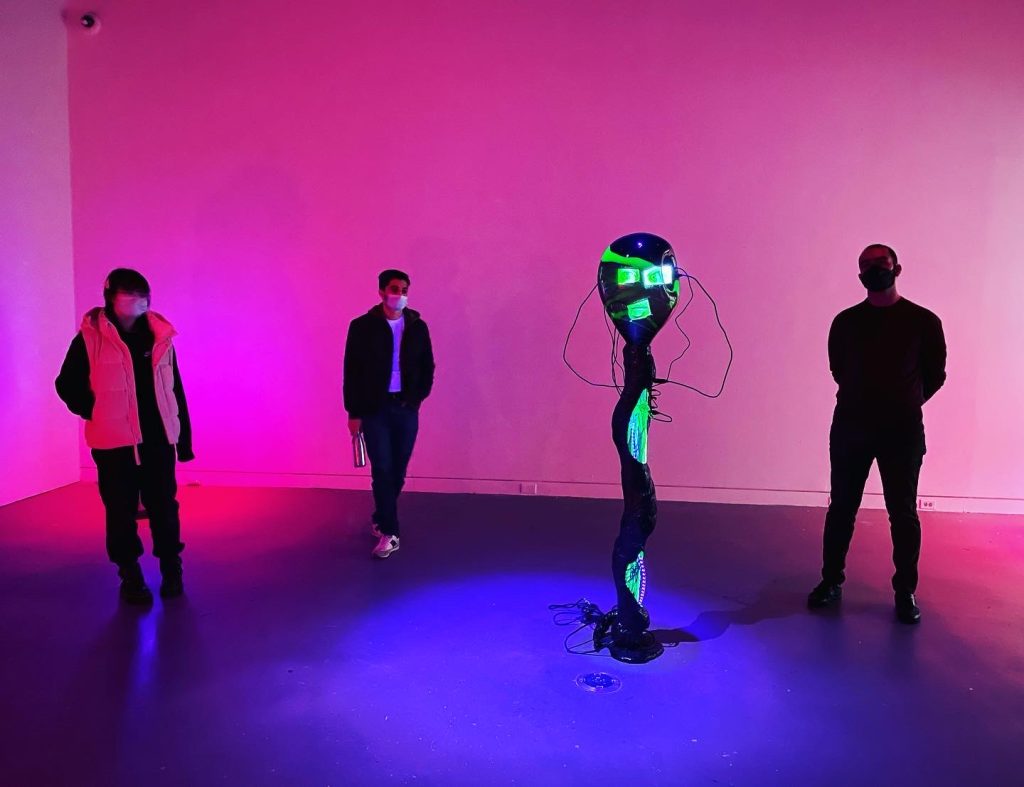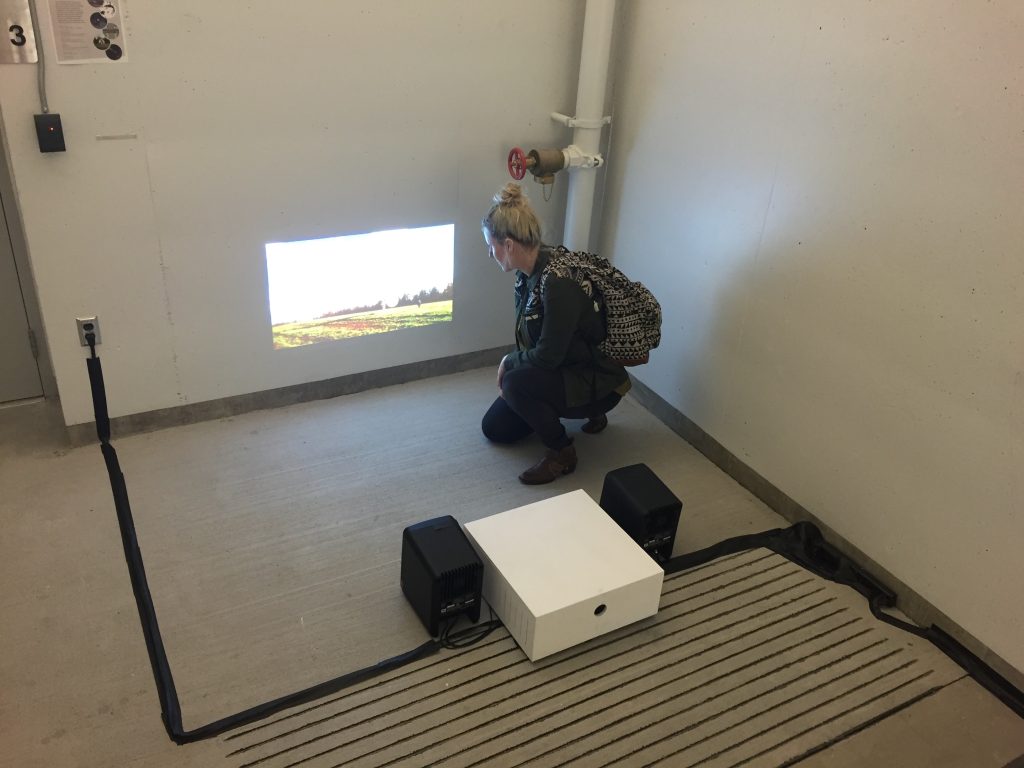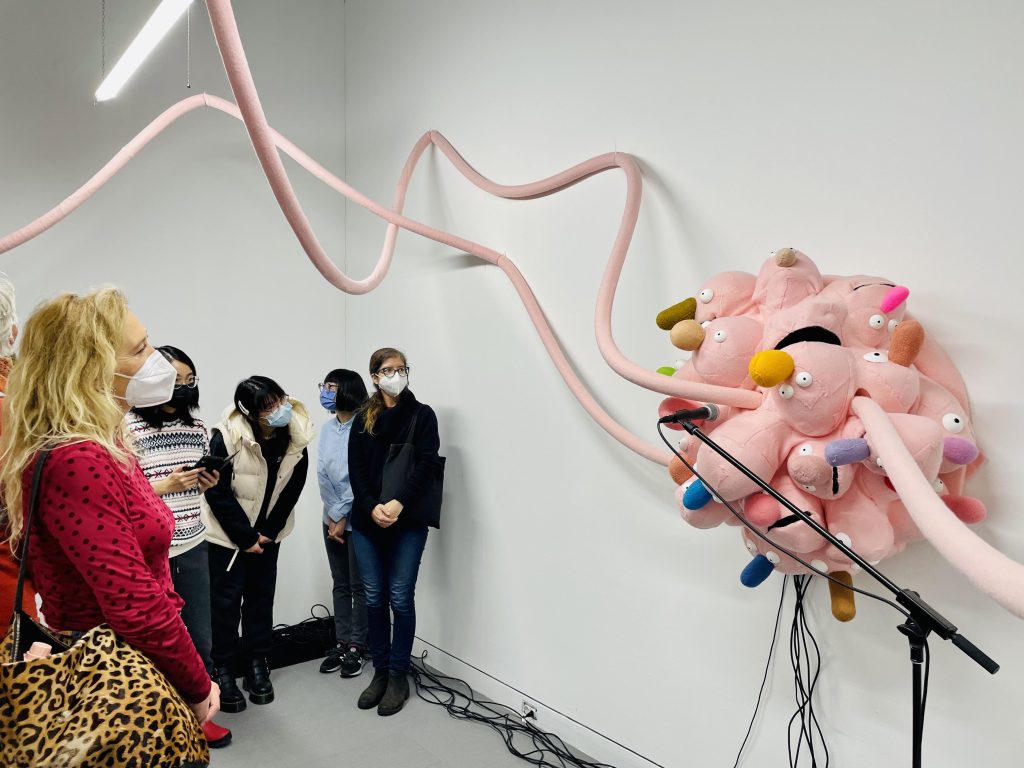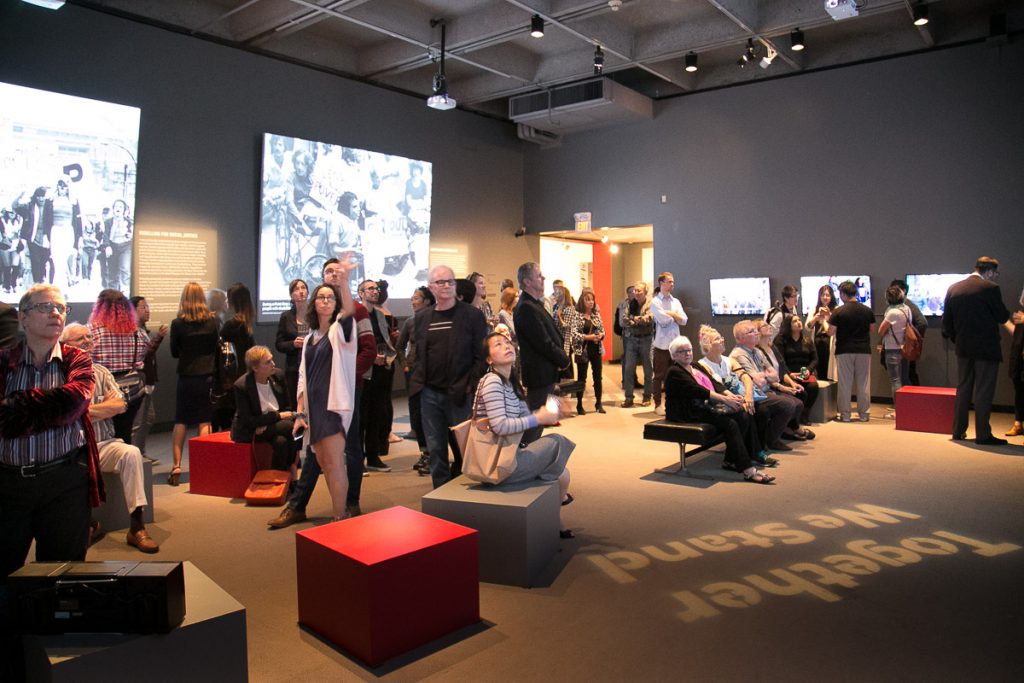I (Kate Hennessy) teach a range of courses in the SIAT Graduate and Undergraduate program. They range from digital image design video production, and introductory writing courses to advanced graduate seminars in the areas of digital museum studies, critical algorithm studies, science and technology studies, and electronic art history. I was an instructor in the UNESCO/Sirindhorn Anthropology Center Museums and Intangible Heritage Field School in northern Thailand (2009-2011).

Haida Now: A Visual Feast of Innovation and Tradition, Museum of Vancouver (2018). Photograph by Rebecca Blissett.
Graduate Courses
Graduation Project — IAT 499 (Spring 2021) [Spring 2021 Showcase]
The goal of the course is for students to complete a project of significant size and scope that allows them to bring together skills and knowledge learned across a variety of courses at SIAT. Individually or as a team of two, students will produce an artifact that is of a high caliber (‘portfolio’ quality) along with a detailed report of the project activities completed throughout the term, the methods or processes used, the knowledge learned, and a description of the final outcomes. Projects will be presented publicly at an end-of-term graduation showcase.

Visiting the New Media Gallery, works by Tony Oursler, 2022. Photo by Kate Hennessy.
Interdisciplinary Approaches to Science, Technology, Culture and Society (IAT 803) (taught Spring 2018, Spring 2020, Spring 2022, Fall 2022)
Interdisciplinary Engagements with Science, Technology, Society and Culture introduces SIAT graduate students to core values of interdisciplinary scholarship through engagement with history, theory and practice in the study of science, technology, society and culture. This course provides a foundational theoretical and historical engagement with literature reflecting interdisciplinary approaches to technology design and use in contemporary society. The course will be a reading-intensive, extended seminar style investigation of theoretical and historical references in science and technology studies and broader societal implications of technologies. It will provide each cohort with critical thinking, reading, and writing foundation for future research and design practices. The course is designed to complement core SIAT courses in Research Design and Computation. The course will address questions such as: How have people been thinking and writing critically about technology, today and in the past? What counts as knowledge in the Arts and Humanities? What counts as knowledge in the Sciences? How can scholars trace their ideas back to those that preceded them in various knowledge traditions? What are some of the major assumptions that underlie how knowledge is produced in diverse disciplines? What are the extra “costs” and “benefits” of interdisciplinary work? Where do knowledge traditions merge and converge, and where/how are they in tension with one another? What are the broader implications of scientific and technological practices for society––for example, our understandings of concepts of race, ethnicity, gender, sexuality, conflict, and history? What are some of the current implications for designers in today’s societal contexts? Students will engage with theory and case studies of how technology and society are intertwined and its implications for the design and use of technology in today’s society.

Computational Poetics installation detail, 2015. Photo by Kate Hennessy
Computational Poetics (IAT 811) (taught in Spring 2016 and Spring 2017) [2016 Blog] [2017 Blog] This graduate level course is a critical exploration of computational art history, theory and practice. Through artistic explorations, readings, seminar discussions, writing and concept design, students learn to identify and explore some of the major issues that artists and designers who are working at the intersection of computing and art face in the milieu surrounding what is variously termed interactive and computational art and its discourses. This course prepares students to critique and contextualize emerging ideas in media art, computational art, biological art, generative art, speculative design and the aesthetics of interaction. It enables students to question assumptions, to locate values and influences, and to determine design tools, artifacts and strategies through which they can communicate, express, perform, generate, represent and/or embody their artistic ideas. Issues such as gender, culture, virtuality, materiality, narrative, presence, identity, biology, computation, space/time and cognition will be explored in relation to the diversity of computational art practice and theory. Particular focus is on the intersection of computation and artistic practices through comparative discussions and enactments of knowledge construction and so-called embodied practices. This includes emerging interdisciplinary, philosophical and cultural influences that currently shape and/or reflect interactive and computational art communities.
New Media and the Museum (IAT 888) (taught in Spring 2012) [Course Website/Blog] Digital technologies have transformed the ways in which museums create access to their collections, how curators do their work, and the ability of publics to participate in the collective writing of local, cultural, and national histories. This course explores histories and theory of museums, and the shifts enacted by the use of new media to organize and exhibit physical and digital collections. Lectures, presentations, and individual research projects relate literature in museum studies, anthropology, cultural studies, and new media to developments associated with digital archives, virtual museums, social media and new media exhibition practices, including mobile applications, tangible interfaces, virtual reality, and augmented reality. In 2012, students participated in the production and evaluation of digital assets being created for the Museum of Vancouver’s exhibition Neon Vancouver. This virtual exhibit and mobile application, called The Visible City: Illuminating Vancouver’s Neon, creatively represents multiple layers of Vancouver’s historical, geographic, visual and material life as a platform for tracing the establishment, demise, and revitalization of Vancouver’s famous neon signs. Based on the evaluation and critique of the Neon exhibit’s digital assets, students will propose individual research projects that draw on their particular skills and apply them to theoretical issues and debates raised in the course readings, in the Museum of Vancouver case study, and in individual research initiatives.

SIAT Graduate Research Colloquium visiting the New Media Gallery, New Westminster. 2022. Photo by Kate Hennessy
Graduate Research Colloquium (IAT 805): The Graduate Research Colloquium is a forum for the building of community, for exposure to diversity of research work and methods, and for fostering understanding of disciplinary commonalities and differences. SIAT (School of Interactive Arts and Technology) is a strongly interdisciplinary program and the Research Colloquium aims to reflect this by exposing students to a broad range of approaches to research in the areas of Interactive Arts, Design and Technologies. Through this colloquium series, presentations by SIAT faculty, SFU non-SIAT faculty, and outside visitors are scheduled alongside presentations by students. Where possible, presentations by international visiting researchers are integrated into the program. The emphasis is on a community of research that includes students.
Undergraduate Courses

Installation view, All Together Now (Museum of Vancouver, 2017) featuring SIAT students’ documentaries about notable collectors and their collections in Vancouver.
Moving Images (IAT 344) [Visit our 344 Vimeo Showcase page] IAT 344 reviews and consolidates the fundamentals of digital video production, including camera and composition skills, the role of sound, lighting and continuity and montage editing in narrative and documentary style. Students will review and analyze works from traditional narrative and documentary cinema and from contemporary digital video. The course will reinforce fundamental skills and extend the student’s abilities to use a range of digital production, post-production and presentation techniques. We routinely collaborate with local community organizations and institutions, most recently the Museum of Vancouver.
In 2020-2022 we embarked on an ambitious project with the Museum of Vancouver called “Isolating Together”, through which we created over 90 short films documenting the pandemic experience, which were exhibited online and in the Museum’s exhibition “Real Time Collecting: Documenting and Remebering Covid-19”. See one of the premiere and award ceremonies from the class below! See our website “Moving Images: Isolating Together” at www.iat344.com
New Media Images (IAT 202) [Visit our 202 Vimeo Showcase]
New Media Images, IAT 202, is an introduction to historical, aesthetic, theoretical and practical issues in digital video production. In this course, students will simultaneously develop technical ability and creative awareness through the combination of lectures, tutorials, projects and hands-on practice. Project planning and conceptualization will be emphasized. Image composition, the basics of soundtrack design, visual effects and editing grammars will be explored toward the aim of creating a final video project.

SIAT student videos exhibited at Museum of Vancouver, “All Together Now”. 2016. Photo by Kate Hennessy
Design Communication and Collaboration (IAT103W)
Art, design and technology are inspiring and productive forces in our world. This course teaches key principles and practices of effective written and visual communication, by engaging students with a broad range of creators, creative expressions, media, and theoretical ideas relevant to the practice of art and design within the context of SIAT. The goal of this course is to teach students essential skills that will enable them to negotiate first year coursework successfully and provide a strong foundation for your academic career. The course’s writing, research, critical thinking and teamwork assignments present a variety of practical learning opportunities designed for students to develop communication and interpersonal skills transferable from the classroom to the professional workplace. Lectures, presentations, readings, film and other materials will help students develop a thoughtful practice of interpreting, writing, and talking about issues related to SIAT so then can contemplate their place within it.

Student documentary videos exhibited in the Museum of Vancouver’s ‘City on Edge: A Century of Vancouver Activism’, 2017.
